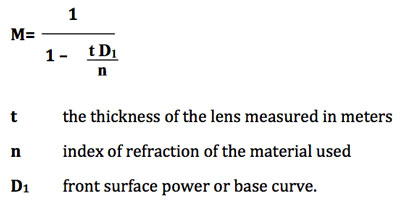- Dioptric power
- Vertex distance
- Base curve
- Center thickness
- Lens material
Minus lenses create minification (negative magnification) which will create a smaller than normal retinal image.
Magnification due to the vertex power and vertex distance of a lens is called the POWER FACTOR. Magnification produced by the shape of the lens – base curve, center thickness and index of refraction – is referred to as the SHAPE FACTOR. Together they determine the TOTAL MAGNIFICATION of an ophthalmic lens.

Let us now analyze the individual components.
POWER FACTOR

All ophthalmic lenses produce magnification. Magnification is expressed as positive or negative. A plus lens magnifies (+), a minus lens minifies. (has negative (-) magnification or minification.) The greater the power, the more it magnifies for a plus lens, or minifies for a minus lens. Furthermore, the vertex distance influences the magnification of a lens; moved away from the eye, magnification increases – moved closer to the eye, magnification decreases.

THE SHAPE FACTOR is determined by the base curve of the lens, its thickness and the material used. The following formula applies:


Rules of Thumb
Aniseikonia only requires correction if there is good correctable vision in both eyes. The general rule of thumb is that if one eye is not correctable to 20/60 or better then fusion of the images will not take place anyway, so a special lens design to correct for image magnification differences is not appropriate. A second concept to note is that the lens design is not intended to either remove magnification or to exactly match the magnification from each lens. It is only necessary to decrease the magnification differences to the point where binocular vision is restored.
Case Study
After cataract surgery in the right eye only, the patient presents the following distance Rx:
OD + 1.00 VA 20/20
OS + 5.00 VA 20/25
The optician suspects that the difference in image size is more than the patient can adapt to and considers designing iseikonic lenses. The following steps need to be taken:
1. Collect lens data
Rx OD + 1.00
OS + 5.00

For the right eye:

For the left eye:

The magnification difference is 8.2% (Mag%OS – Mag%OD)
We know that clinical symptoms may show up with differences of three to five percent. Therefore, 8.2 percent magnification difference surely calls for the design of iseikonic lenses.
There are four variables we can change to reduce the magnification difference:
- Vertex distance
- Material – index of refraction
- Base curve
- Center thickness

The resultant magnification difference is three percent. This will enable the patient to wear the new prescription comfortably, achieving good binocular vision.
While you may not design many iseikonic lenses in your optical career, it certainly makes you a more knowledgeable and well rounded optician to understand why and how. To work through the magnification formula stimulates your brain and to some of us, it is fun.
However, as you may guess, there is an app for that, too.


Since she came to Florida in 1987, she has worked diligently to promote high professional standards in opticianry. Her mission is to help opticians achieve their personal success through serving the public as vision experts.
As a professional development coach Maggie provides education workshops that focus on leadership and personal engagement. Her time management course has inspired many participants to think outside the box, apply newly acquired knowledge and achieve extraordinary results.
Maggie's enthusiasm for opticianry is inspiring and her keen business sense paired with excellent communication skills make her a highly sought after motivational speaker.












